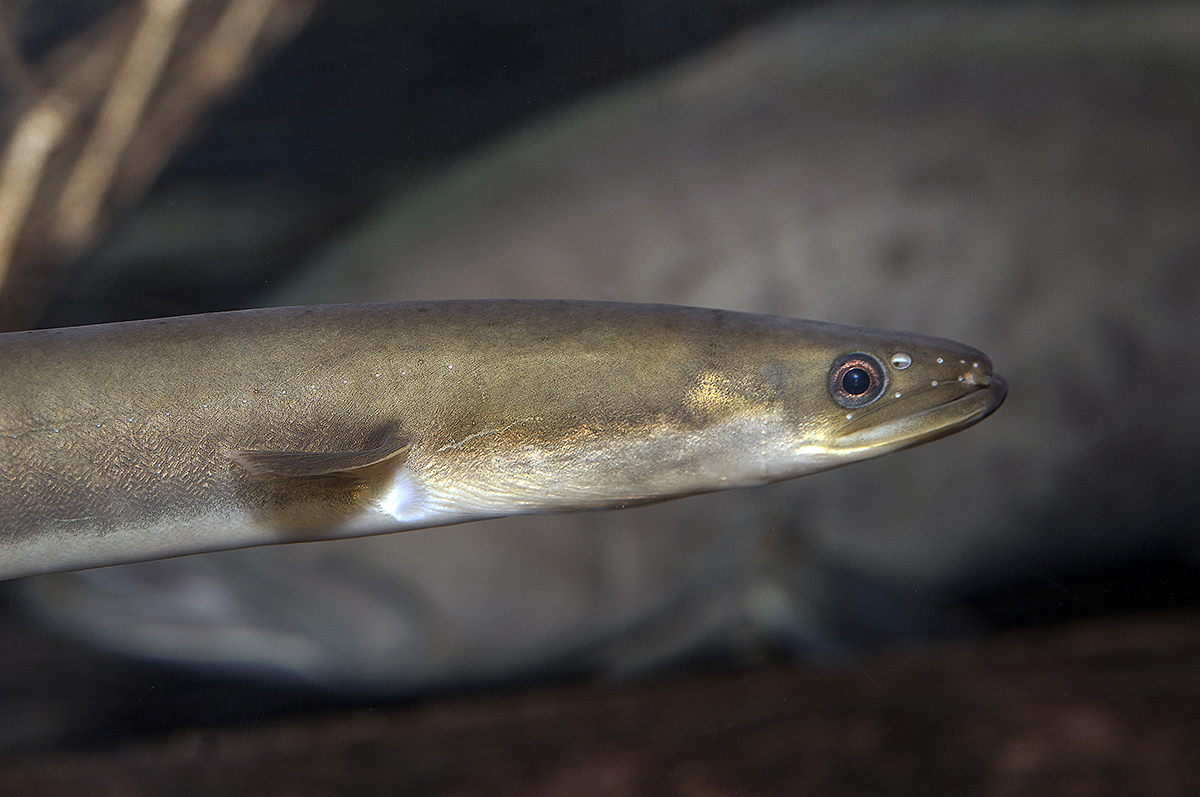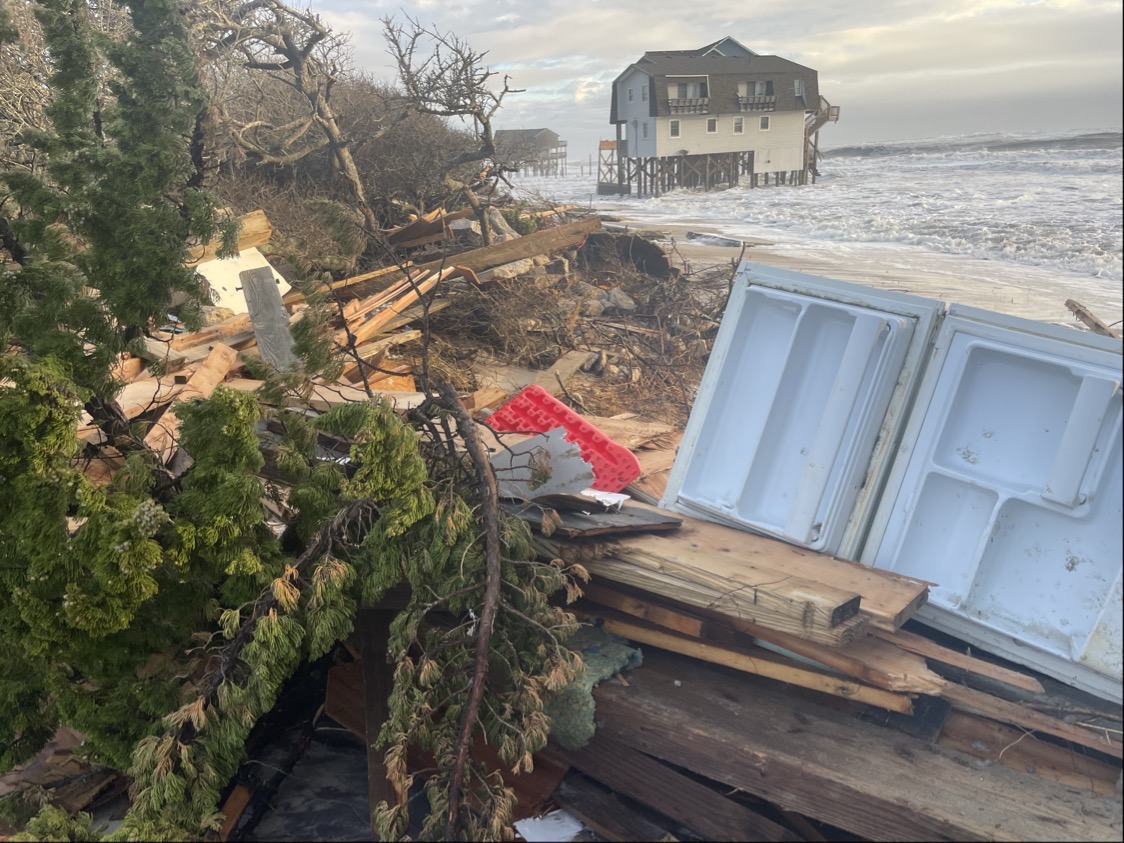
This time each year, rivers and streams throughout coastal North Carolina are teeming with migratory fish during their annual spawning run.
River herring, Atlantic and shortnose sturgeon and American eel are among those moving upriver. Early last year, we brought you stories on two additional migratory species found in coastal North Carolina waters: striped bass and American shad.
Supporter Spotlight
A single river may see only a few individuals, while others may have thousands of migratory fish per year. From the earliest times, pre-Colonial days into the 20th century, river herring, sturgeon and eels have been considered an important food source, often eagerly awaited after harsh winters.
Alewife and blueback herring
River herring are actually two distinct species, the alewife and the blueback, but the two are so closely related as to be almost indistinguishable. So, the common name river herring is generally used for both.
River herring are anadromous, meaning that they feed in saltwater most of their life, but return to freshwater to reproduce. They are found along the entire East Coast, ranging from Nova Scotia to the St. Johns River in northern Florida and migrating up and down the coast with the change of seasons.
“River herring in North Carolina will spawn in late February, through early May. The alewives arrive first, spawning in ponds or slow-moving water when the water temperature is about 55 to 61 degrees Fahrenheit. Blueback herring will arrive three to four weeks later, spawning in faster-moving streams when the water temperature reaches about 58 to 61 degrees. Each female will release an average of over 100,000 eggs directly into the water. Both species spawn in groups, scatter their eggs, and cease spawning when water temperatures rise above 81 degrees Fahrenheit. A large number of eggs are necessary because only a limited number will survive the summer months to make the journey out to the sea,” said Holly White, North Carolina Division of Marine Fisheries river herring biologist.
Alewife eggs will settle to the bottom of still pond waters, while the blueback’s eggs will tumble along the bottom gravel streambeds, she said. The eggs are fertilized by milt from males and both species’ eggs will hatch into larvae in three to seven days after spawning, depending upon water temperatures.
Supporter Spotlight
Larvae will spend the early summer months feeding and being fed upon. All life stages of river herring are highly utilized forage species for many riverine, estuarine and marine piscivorous species, including airborne predators.
“River herring are important prey for other fish species jointly managed by federal and state governments, including bluefish, American eel, striped bass and weakfish. Freshwater species such as largemouth bass, pumpkinseed, redfin pickerel, shiners, walleye, white bass, white perch and yellow perch also consume river herring,” White said.
River herring primarily feed on zooplankton, although fish eggs, crustacean eggs, insects and insect eggs are also important foods aiding in development. Larvae begin feeding on zooplankton immediately upon formation of a functional mouth, at about a quarter of an inch in length. By summer’s end, the young herring have grown to be about 1 to 2 inches long.
As autumn temperatures begin to drop, river herring make the return journey back to the sea. After three to four years of feeding at sea, herring will make their first spawning run back to the area of their birth. Adults may return to spawn more than once, although the number returning to spawn is reduced as they age.
“Once river herring emigrate from North Carolina’s estuarine waters to the ocean, they migrate north, between 40 and 43 degrees north latitude, to Nantucket Shoals, Georges Bank and the Gulf of Maine to join the coastwide population on the overwintering grounds. In the early spring, mature river herring begin the migration south. Herring native to North Carolina waters will return to the general area in which they were born. Following spawning, both males and female emigrate from the rivers and return to the ocean. River herring spend the summer months in the waters above 40 degrees north latitude, feeding on plant and animal zooplankton,” White said.
River herring are an important link in the coastal ecosystem, providing a vital source of food for stripped bass and bluefish, as well as herring gulls. Nesting osprey and bald eagles also prey on herring to feed their young.
“River herring in North Carolina made up one of the largest freshwater fisheries in the world. Due to loss of available spawning habitat, high fishing mortality and lower water quality, river herring landings in North Carolina began to decline in the mid- to late 1980s,” she said.
Since 2007, the commercial and recreational harvest of river herring has been prohibited in all coastal-joint-inland waters of the state, she said.

American Eel
American eels are catadromous, meaning this species spends most of its life in freshwater, rivers, streams, ponds and lakes, but returns to the sea to reproduce.
This species begin their lives’ journey spawning in the Sargasso Sea near Bermuda, in the North Atlantic. Their eggs hatch out into larvae, which are brought by prevailing currents back to the Atlantic Coast of northern South America, and the Gulf coast.
“As they grow, American eels undergo a metamorphosis and change their appearance dramatically. Their name depends upon the age of the fish, which is determined by the coloration of their body and size. Eels first returning to their home rivers are called glass eels, which are translucent and almost impossible to see with the naked eye,” said Todd Mathes, North Carolina Division of Marine Fisheries American eel biologist.
These small fish are between 1 and several inches in length. As they grow, reaching about 6 inches in length, they undergo another change, gaining pigmentation and looking more like baby eels.
“During the next stage of development, the eels turn yellow in color and are called, you guessed it, yellow eels,” Mathes said. “Finally, when the animals grow to between 2 feet and 5 feet in length and become sexually mature, they are called silver eels.”
The sex of American eels isn’t determined until they are about 7.9 to 9.8 inches in length. The determining factor on whether they become male or female is the numbers of eel available in a particular ecosystem. Female eels grow the quickest, and may grow to be 4 to 5 feet in length. Generally, any eel larger than 12.99 inches is considered to be a female. Once an adult eel, they turn silver with larger eyes. When close to becoming sexually mature, the eels start moving back down to the ocean, and will swim some 3,000 miles to the Sargasso Sea.
“That is where all American eels go to spawn. It is generally assumed that the adults die after spawning. The exact details are still unknown,” Mathes said.
Scientists believe the highly adaptive American eel has some of the most diverse habitats of any species of fish found on the planet. In North Carolina, estuarian habitats, like those found in the Albemarle-Pamlico Sound region, provide the earlier life stages a good home. Lakes and ponds have historically been considered among the most important habitats for the eels to mature and grow, because most eels that grow up in these freshwater environments typically become females.
“At one time, American eels were found throughout all of North Carolina’s coastal waters, even described by early fish collectors as ‘everywhere abundant’ in the upper Catawba River. The American eel finds fresh water habitat in North Carolina in streams and large rivers in the Piedmont and coastal plain regions, but numbers are greatly reduced upstream of many dams,” said Mathes.
Hydroelectric and other dams block or slow movements of elvers, or a young eel, and subadult eels to upstream habitats. American eels continue to be distributed throughout the lower areas of watersheds closest to the sea and sounds. They are prevented from reaching extreme headwaters where they had historically been reported as “everywhere common” in 1889 by scientist D.S. Jordan.

Atlantic, shortnose sturgeon
All five U.S. Atlantic sturgeon distinct population segments are listed as endangered or threatened under the Endangered Species Act. A distinct population segment is the smallest division of a species permitted to be protected under the act. An endangered species is one in danger of becoming extinct.
Atlantic sturgeon that hatch out in Gulf of Maine rivers are listed as threatened, and those that hatch out in other U.S. rivers are listed as endangered.
“The distinct population segment most common to North Carolina waters is the Carolina Distinct Population Segment, which is listed as endangered. In North Carolina, the Albemarle Sound, most likely the Roanoke River population, has between 16 and 22 adult individuals,” said Andy Herndon, biologist with the National Oceanic and Atmospheric Administration, or NOAA, Fisheries.
“Adult spawning runs of Atlantic sturgeon are still not completely understood. In rivers from Georgia to the Chesapeake Bay, scientists have confirmed that adult sturgeon spawn during the late summer and fall. In rivers from Delaware to Canada, adults spawn in the spring and early summer,” he said.
“Shortnose sturgeon live in rivers and coastal waters from Canada to Florida. They hatch in the freshwater of rivers and spend most of their time in the estuaries of these rivers. Unlike Atlantic sturgeon, shortnose sturgeon tend to spend relatively little time in the ocean. When they do enter marine waters, they generally stay close to shore. In the spring, adults move far upstream and away from saltwater, to spawn. After spawning, the adults move rapidly back downstream to the estuaries, where they feed, rest, and spend most of their time,” he said.
Currently, shortnose sturgeon are found in 41 rivers and bays along the East Coast, spawning in 19 of those rivers and comprising three “metapopulations,” or reproductively isolated groups, Herndon said. These three metapopulations include the Carolinian Province, or southern metapopulation; the Virginian Province, or mid-Atlantic metapopulation; and Acadian Province, or northern metapopulation.
In North Carolina, shortnose sturgeon are currently found in the Roanoke and Cape Fear rivers, as well as Albemarle Sound and Pamlico Sound. Shortnose sturgeon are considered rare in North Carolina waters.
As adults, Atlantic sturgeon travel extensively throughout the marine environment, mingling with fish from other distinct population segments. Juvenile and adult Atlantic sturgeon use estuaries for feeding throughout the year. Younger animals generally remain solely within the estuaries to feed and grow, while older animals may feed in the estuaries to feed before migrating. Like the shortnose sturgeon, Atlantic sturgeon swim far upstream, sometimes over 100 miles, in rivers to find rocky habitats in freshwater for spawning.
“Once they successfully spawn, the adults move quickly back downstream to the estuaries. The eggs they left behind hatch, and the larvae mature as they slowly move downstream toward the estuaries. Once they reached the estuary, the larvae are now more fully developed and considered ‘young of the year.’ They generally remain in the estuary for two to three years to continue to grow and mature before eventually heading into the marine environment,” Herndon said.
Shortnose sturgeon have a very similar life history as the Atlantic sturgeon. The primary difference is shortnose sturgeon enter the marine environment infrequently compared to Atlantic sturgeon. Shortnose sturgeon spend the majority of their lives in their natal river systems.
“Sturgeon present in North Carolina waters are bottom feeders that use their four barbels to search for food in the sandy, muddy bottom of rivers. They use a vacuum-like mouth to suck up this bottom-dwelling food, typically eating invertebrates such as insects, crustaceans, worms and mollusks. Atlantic sturgeon may even feed on bottom-dwelling fish such as sand lance,” Herndon said.
Although neither Atlantic nor shortnose sturgeon can be targeted by fishermen, threats remain that continue to affect recovery efforts. Bycatch in commercial fisheries and increased industrial uses such as hydropower, nuclear power and treated sewage discharge into coastal rivers during the 20th century became the primary barriers to Atlantic and shortnose sturgeon recovery.
The management of sturgeon in North Carolina waters is a partnership between state and federal resource managers. NOAA Fisheries has the primary lead in promoting recovery and conservation of sturgeon with respect to their listing under the federal Endangered Species Act.
The North Carolina Wildlife Resources Commission is the state agency tasked with managing and conserving threatened and endangered species in North Carolina. They also play a significant role in helping to manage and conserve sturgeon.
The North Carolina Division of Marine Fisheries is also a partner in the conservation of sturgeon as they collect information on the species occurrence, and work to reduce sturgeon bycatch in state fisheries. The North Carolina Division of Marine Fisheries in 1991 made it illegal to possess sturgeon from North Carolina waters.
“We believe that one of the best ways to help save these amazing species is by getting the word out through outreach. Our scientists are working with students and teachers to learn more about the movements, behavior, and threats to Atlantic and shortnose sturgeons along the East Coast. The Students Collaborating to Undertake Tracking Efforts for Sturgeon (SCUTES) program provides lesson plans, educational kits, and an opportunity for classrooms to adopt a tagged sturgeon,” Herndon said.
Learn more about the SCUTES Program.







